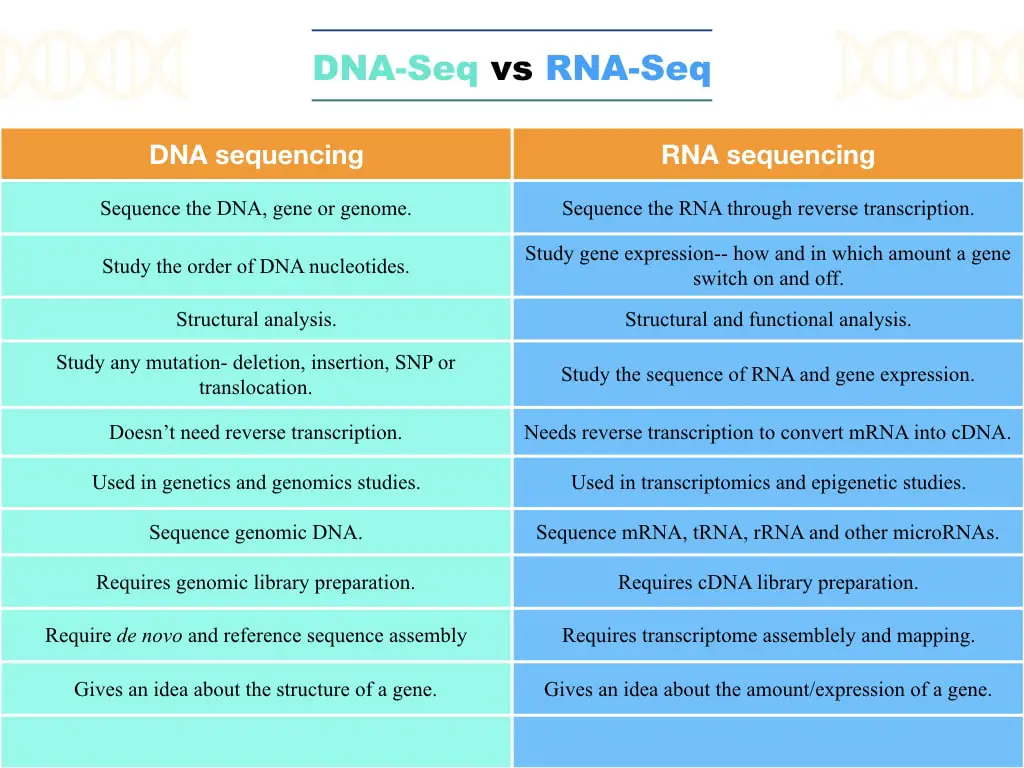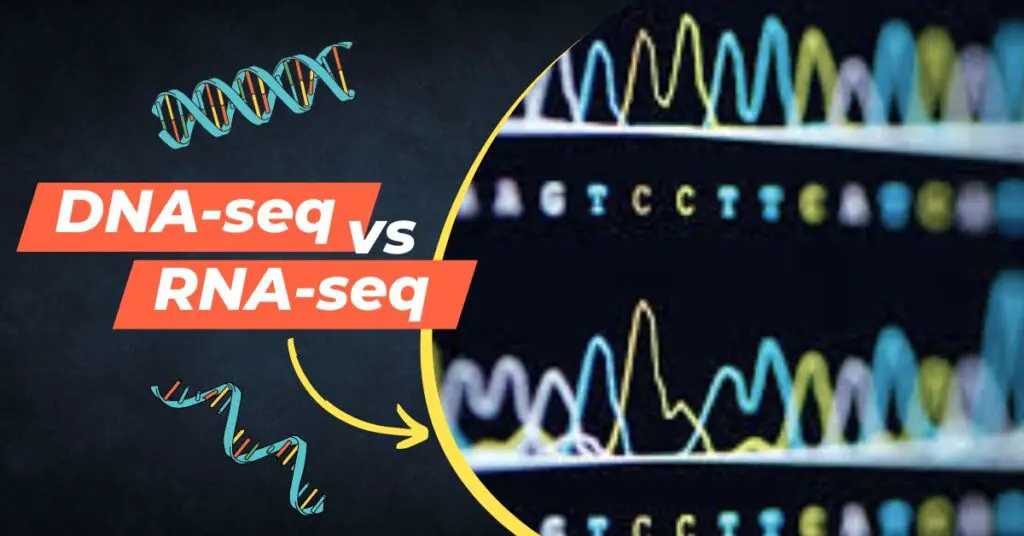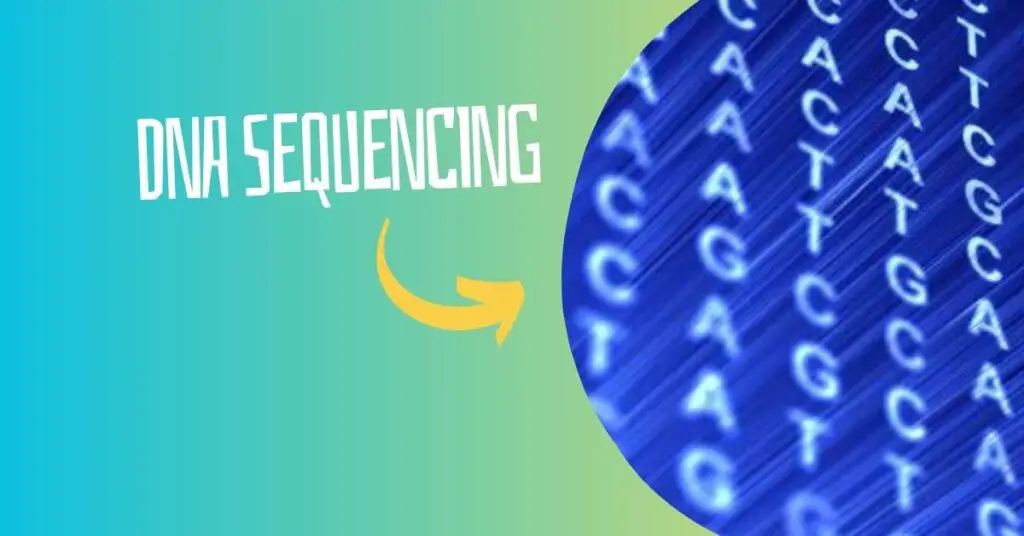“DNA-seq and RNA-seq both are nucleotide sequencing platforms that can read individual nucleotides in a sequence. Let us explore some of the common differences between DNA sequencing vs RNA sequencing.”
Sequencing has emerged as an extensive tool that enables us to read nucleotide sequences. Any sequencing platform can understand and read the order of nucleotides present in the sample and give us the power to know sequence-level alterations.
Two types of nucleotide sequencing platforms are DNA sequencing (DNA-seq) and RNA sequencing (RNA-seq). Both platforms are exclusively used in genetics and genomics research. They can study a gene sequence, find alterations within a gene or genome, study gene expression and do a lot more.
However, while both the DNA-seq and RNA-seq are a kind of nucleotide sequencing technique, they also differ in many aspects. Each technique has a different experiment design, output and applications. Therefore needs different computational programs, tools and expertise for performing each technique.
In this article, I will demonstrate some of the common, important and technical differences between DNA-seq vs RNA-seq including their advantages, limitations and applications. I will also provide a guide on how and when you can use it and associated resources that you can use to learn individual techniques.
By the end of this article, you will learn when and how to use DNA-seq and RNA-seq which eventually strengthen your sequencing knowledge.
Stay tuned.
Key Topics:
DNA-Seq vs RNA-Seq
I will start with some basic differences and then move to conceptual and technical differences for more advanced knowledge.

Concept:
DNA-seq is a DNA sequencing technology that can sequence the DNA nucleotides from any sample. RNA-seq is RNA sequencing technology that can sequence the RNA nucleotide by reverse transcription.
Use:
DNA sequencing reads the sequence of any unknown DNA, gene and genome while RNA sequencing reads an RNA sequence as well as provides quantitative information. Means provides information regarding which genes are turned ‘on’ or ‘off’ and in which amount.
What does it do?
RNA sequencing investigates total cellular RNA content including mRNA, tRNA, rRNA and other smaller RNAs while DNA sequencing investigates total genomic DNA.
So conceptually, DNA sequencing gives us an idea about the structure of a sequence or a gene while RNA sequencing gives us an idea about the function of a gene.
| DNA-seq | RNA-seq |
| Structure of a gene | Function of a gene |
| Qualitative analysis | Qualitative and quantitative analysis |
| Sequence-level genetic alteration | Sequence-level expression |
| Presence or absence of nucleotide | Gene on or off |
| Genetics and genomic studies. | Transcript, transcriptomics, epigenetics and gene expression studies. |
| Total cellular DNA. | Total cellular RNA (tRNA, rRNA, mRNA) |
Thus DNA sequencing has been widely utilized in genetics and genomic studies while RNA sequencing is extensively utilized in transcriptomics, gene expression and epigenetic studies.
Note:
Transcriptomics: a study of the entire RNA of the genome.
Techniques:
Common DNA sequencing techniques are targeted sequencing, amplicon sequencing, whole-genome sequencing, whole-exome sequencing and molecular inversion probe sequencing while common RNA sequencing techniques are whole-transcriptome sequencing, ribosomal RNA depletion and targeted gene expression study with RNA sequencing.
| DNA sequencing Technique | Function |
| Targeted sequencing | Specific or target mutation in the sequence. |
| Amplicon sequencing | Sequence amplified (specific) region from the genome. |
| Whole genome sequencing | Sequence the entire genome |
| Exome sequencing | Sequence coding regions |
| RNA sequencing Technique | Function |
| Single-cell RNA sequencing | Sequencing total cellular RNA from a single cell. |
| mRNA sequencing | Sequencing only the mRNA from a cell. |
| Whole-transcriptome sequencing | Sequencing total mRNA content of a cell. |
| RNA sequencing for targeted gene expression | Study gene expression of a particular gene. |
Process and steps:
DNA sequencing is an easy and straightforward method that includes the steps of DNA isolation, fragmentation, library preparation, sequencing and analysis. On the other hand, RNA sequencing includes steps of RNA isolation, reverse transcription, library preparation, library enrichment, sequencing and analysis.
An additional step of reverse transcription in which the mRNA is converted into the cDNA is required to perform the RNA-seq and doesn’t need during DNA-seq. However, both techniques are equally difficult, and sensitive and need the expertise to perform and interpret the results.
The enzyme reverse transcriptase polymerase is needed to convert the mRNA into cDNA for RNA sequencing which isn’t needed during DNA sequencing.
So it’s now clear that genomic library preparation is required for DNA sequencing while cDNA-library preparation is required for RNA sequencing. However, both the library preparation process is almost similar except for the reverse transcription step of mRNA. I have given links for individual library preparation article, you can read it.
Steps in DNA-seq vs RNA-seq:
| DNA isolation | RNA isolation |
| DNA fragmentation | Reverse transcription |
| Genomic DNA Library preparation | cDNA library preparation |
| Library enrichment (optional) | Library enrichment |
| Sequencing | Sequencing |
| Data analysis | Data analysis |
Data analysis:
The scheme of data analysis for both DNA and RNA sequencing is also entirely different. DNA sequencing data is aligned with the reference sequence or processed de novo, while RNA sequencing data needs transcriptomics assembly or mapping.
Hence, additional pipelines and tools are required to understand, study and interpret the RNA sequencing data.
Advantages:
| DNA sequencing | RNA sequencing |
| Wide dynamic range for genomic DNA. | Wide dynamic range for RNA. |
| High-resolution. | Qualitative and quantitative analysis. |
| Structural analysis. | Capture both known and unknown alterations. |
| Capture both known and unknown sequence variants. | Study the entire transcriptome. |
| Find rare, common, casual and pathogenic variants. | Applied to any species. |
| Study the entire genome. | Applied even if the reference sequence isn’t available. |
| Applied to any species. | |
| Reference sequences are available to compare. |
Limitations:
Both DNA and RNA sequencing has several limitations as well but RNA sequencing has its own challenges and problems.
Scientists have to isolate a pure genomic RNA for the RNA sequencing purpose which is quite a difficult, laborious, time-consuming and challenging task. RNA is fragile and more prone to RNase degradation.
Hence, it’s a challenging task to obtain high-quality and high-yield RNA. Conversely, DNA isolation is a relatively easy scheme. Once we get the DNA, we can store it without any degradation.
The quantity of RNA in our cells is also very low compared to DNA, resultantly, library preparation fails, sometimes due to low yield. A high abundance of cellular DNA gives us a high yield DNA and helps in excellent library preparation.
RNA sequencing is a highly sensitive technique compared to DNA sequencing. The lab personnel has to deal with low-volume samples, due to the high degradation rate of RNA.
RNA sequencing is a comparatively costlier technique than DNA sequencing, as it seeks additional experimental steps, tools and instruments.
DNA sequencing can give us an idea about the sequence variant only and doesn’t provide gene expression information, while RNA sequencing reads sequence variants for transcriptomics studies, comparative analysis, and splice variants analysis, and provides information on gene expression.
How to choose DNA-seq vs RNA-seq?
Here is a comprehensive guide on when to use which platform.
If you want to study a gene, DNA or genome, sequence variants, SNPs, indels, pathogenic variants, novel genomic regions and an unknown sequence, choose DNA sequencing. If you want to study tissue or cell-level gene expression, transcript, transcriptomics and smaller RNAs, choose RNA sequencing.
Wrapping up:
Both DNA-seq and RNA-seq are important techniques in genetic science, one enables DNA studies while another RNA and gene expression studies. Recent advancements in the present technologies can also be used in medical and clinical science.
Pathogenic disease-causing variants can be investigated by DNA sequencing while disease-associated gene expression alterations can be investigated by RNA sequencing. Furthermore, these techniques are utilized in microbial genetics and metagenomics analysis as well.
I hope you like the present article. Read other related articles on our blog, do bookmark this page and share this article.



